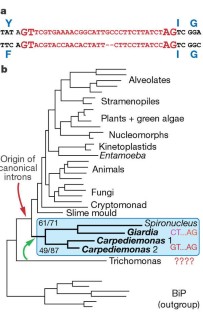Early origin of canonical introns (original) (raw)
- Brief Communication
- Published: 19 September 2002
Eukaryotic evolution
Nature volume 419, page 270 (2002)Cite this article
- 960 Accesses
- 52 Citations
- 1 Altmetric
- Metrics details
Abstract
Spliceosomal introns, one of the hallmarks of eukaryotic genomes, were thought to have originated late in evolution1,2 and were assumed not to exist in eukaryotes that diverged early — until the discovery of a single intron with an aberrant splice boundary in the primitive 'protozoan' Giardia3. Here we describe introns from a close relative of Giardia, Carpediemonas membranifera, that have boundary sequences of the normal eukaryotic type, indicating that canonical introns are likely to have arisen very early in eukaryotic evolution.
This is a preview of subscription content, access via your institution
Access options
Subscribe to this journal
Receive 51 print issues and online access
$199.00 per year
only $3.90 per issue
Buy this article
- Purchase on SpringerLink
- Instant access to full article PDF
Prices may be subject to local taxes which are calculated during checkout
Additional access options:
Figure 1: Introns and evolutionary affinities of Carpediemonas.

Similar content being viewed by others
References
- Palmer, J. D. & Logsdon, J. M. Curr. Opin. Genet. Dev. 1, 470–477 (1991).
Article CAS Google Scholar - Logsdon, J. M. Curr. Opin. Genet. Dev. 8, 637–648 (1998).
Article CAS Google Scholar - Nixon, J. E. J. et al. Proc. Natl Acad. Sci. USA 99, 3701–3705 (2002).
Article ADS CAS Google Scholar - Simpson, A. G. B. & Patterson, D. J. Eur. J. Protistol. 35, 353–370 (1999).
Article Google Scholar - Simpson, A. G. B. et al. Mol. Biol. Evol. 19, 1782–1791 (2002).
Article CAS Google Scholar - Cavalier-Smith, T. Trends Genet. 7, 145–148 (1991).
Article CAS Google Scholar - Embley, T. M. & Hirt, R. P. Curr. Opin. Genet. Dev. 8, 624–629 (1998).
Article CAS Google Scholar - Roger, A. J. Am. Nat. 154 (suppl.), 146–163 (1999).
Article Google Scholar - Sogin, M. L. Curr. Opin. Genet. Dev. 7, 792–799 (1997).
Article CAS Google Scholar - Johnson, P. J. Proc. Natl Acad. Sci. USA 99, 3359–3361 (2002).
Article ADS Google Scholar - Archibald, J. M., O'Kelly, C. J. & Doolittle, W. F. Mol. Biol. Evol. 19, 422–431 (2002).
Article CAS Google Scholar - Fast, N. M., Logsdon, J. M. & Doolittle, W. F. Mol. Biochem. Parasitol. 99, 514–522 (1999).
Article Google Scholar - Dacks, J. B. & Roger, A. J. J. Mol. Evol. 48, 779–783 (1999).
Article ADS CAS Google Scholar
Author information
Authors and Affiliations
- Department of Biochemistry and Molecular Biology, Canadian Institute for Advanced Research, Program in Evolutionary Biology, Dalhousie University, Halifax, B3H 4H7, Nova Scotia, Canada
Alastair G. B. Simpson, Erin K. MacQuarrie & Andrew J. Roger
Authors
- Alastair G. B. Simpson
- Erin K. MacQuarrie
- Andrew J. Roger
Corresponding author
Correspondence toAlastair G. B. Simpson.
Ethics declarations
Competing interests
The authors declare no competing financial interests.
Additional information
brief communications is intended to provide a forum for both brief, topical reports of general scientific interest and technical discussion of recently published material of particular interest to non-specialist readers. Priority will be given to contributions that have fewer than 500 words, 10 references and only one figure. Detailed guidelines are available on Nature's website (http://www.nature.com) or on request from nature@nature.com
Rights and permissions
About this article
Cite this article
Simpson, A., MacQuarrie, E. & Roger, A. Early origin of canonical introns.Nature 419, 270 (2002). https://doi.org/10.1038/419270a
- Issue Date: 19 September 2002
- DOI: https://doi.org/10.1038/419270a